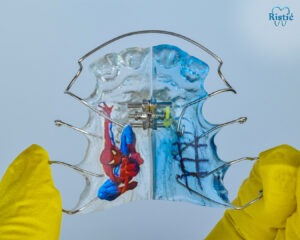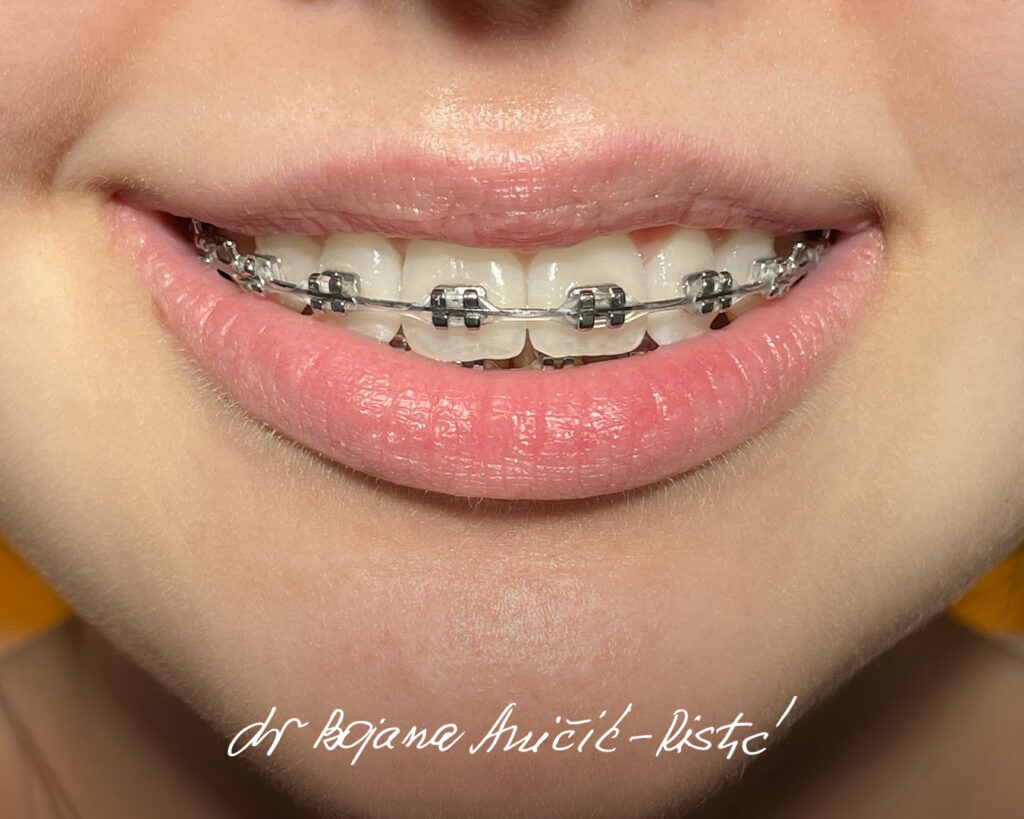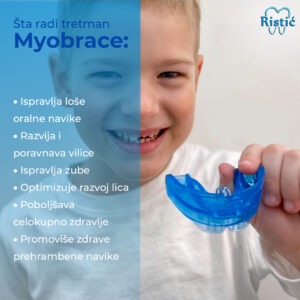Orthodontics
Jaw orthopedics is a dentistry branch dealing with the prevention and therapy of tooth, jaw, and face irregularities. Misaligned teeth do not only represent an aesthetic flaw but also the cause of cavity occurrences, periodontal diseases, problems with speech and food consumption, and jaw joint pain. The duration of an orthodontal therapy depends on the severity of the problem but lasts between one and three years in most cases. The best time to do the first orthodontal checkup is when a child turns seven, i.e. when the first milk tooth falls out.
 Orthodontic appliances can be mobile and fixed. The fundamental characteristic of mobile appliances is that they can be removed from the mouth. They are aimed at the youngest of patients who are still growing and developing. During this period, we can still adjust jaw relations, change bad habits, fix irregularities related to bite height, swallowing, and speech, and preserve space for unerupted teeth.
Orthodontic appliances can be mobile and fixed. The fundamental characteristic of mobile appliances is that they can be removed from the mouth. They are aimed at the youngest of patients who are still growing and developing. During this period, we can still adjust jaw relations, change bad habits, fix irregularities related to bite height, swallowing, and speech, and preserve space for unerupted teeth.
Mobile appliances are worn for 14 hours each day, so the child’s cooperation is crucial for a successful therapy. If the teeth are greatly rotated, crooked, or have erupted in the wrong place, a mobile appliance therapy is the first phase of the overall procedure, followed by the placement a fixed appliance as the therapy’s final step.
Fixed orthodontic appliances i.e. brackets are placed on teeth exclusively by a jaw orthopedics specialist and the patients cannot remove them by themselves. In our clinic, we only use the brackets from well-established manufacturers and the most modern Damon system for fixed orthodontic appliances. Their most important characteristic is the light biological constant force which adjusts teeth into proper
position.
Fixed orthodontic appliances do not damage teeth and do not cause cavities, decalcifications, or gum diseases. However, if a proper mouth and teeth hygiene isn’t maintained, food leftovers can cause the appearance of white spots on the teeth and gum inflammations.


In our clinic, you will receive essential advice on preserving oral cavity hygiene and information about proper diet during the orthodontic treatment.
The retention phase or the tooth position retention takes place after a successful orthodontic therapy. A patient receives a mobile or fixed retention appliance which holds the teeth in a straight position. We cannot guarantee the results’ stability if the patient does not wear the retainer.
 Dental correction foils are transparent, designed through software by using the imprint taken in the clinic. They are aesthetically acceptable, detachable, washable, comfortable to wear, and their forces are distributed along the entire surface of each tooth. The foils are worn at least 18 hours a day and the number of foils is determined after a detailed jaw and tooth imprint analysis.
Dental correction foils are transparent, designed through software by using the imprint taken in the clinic. They are aesthetically acceptable, detachable, washable, comfortable to wear, and their forces are distributed along the entire surface of each tooth. The foils are worn at least 18 hours a day and the number of foils is determined after a detailed jaw and tooth imprint analysis.
Orthodontic mini-implants are used as aids in fixed appliance therapies. They are embedded into the bone simply and painlessly. We apply their use in therapy in order to further increase the treatment’s efficiency and quality.
 Myobrace appliances or myofunctional appliances-trainers help remove bad oral habits, such as mouth breathing or thumb sucking. Myobrace appliance therapy is focused on fixing the common causes of crowded or crooked teeth by using an appliance that develops both jaws and straightens teeth. The treatment is suitable for children aged 3–15. However, there are appliances which offer solutions even for snoring, gnashing, or the appearance of recidivations after wearing fixed appliances in adults. Myobrace appliances are worn at night and for 1–2 hours during the day together with doing some corresponding tongue and lip exercises, making the therapy more successful and entertaining.
Myobrace appliances or myofunctional appliances-trainers help remove bad oral habits, such as mouth breathing or thumb sucking. Myobrace appliance therapy is focused on fixing the common causes of crowded or crooked teeth by using an appliance that develops both jaws and straightens teeth. The treatment is suitable for children aged 3–15. However, there are appliances which offer solutions even for snoring, gnashing, or the appearance of recidivations after wearing fixed appliances in adults. Myobrace appliances are worn at night and for 1–2 hours during the day together with doing some corresponding tongue and lip exercises, making the therapy more successful and entertaining.
Copyright 2025 | Coded and designed by Dinulović Dejan
